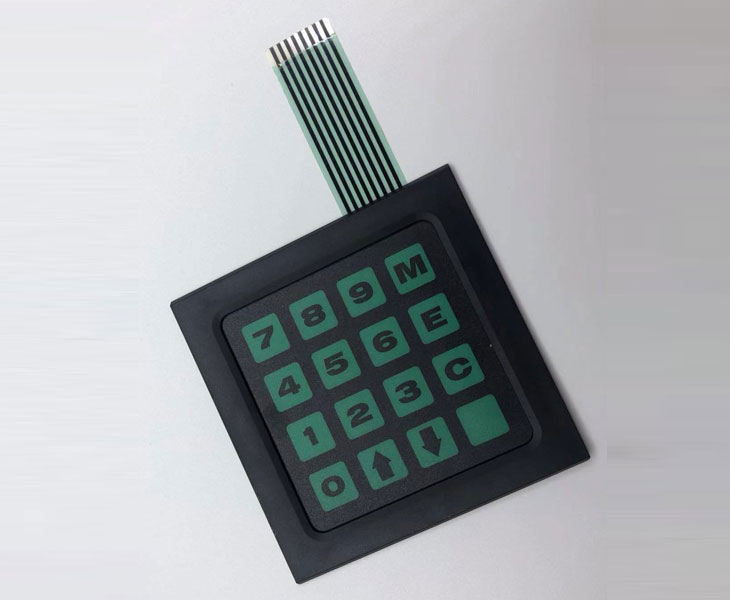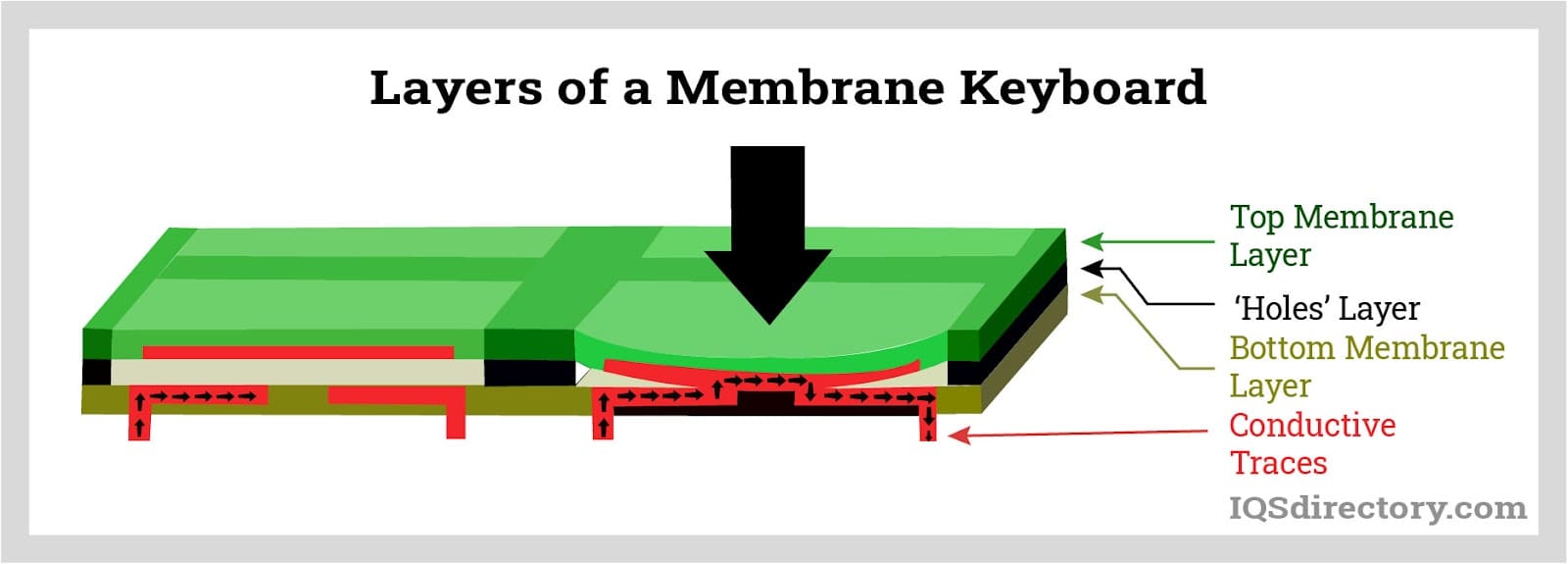Recognizing the Significance of Membrane Layer Switch Over in Modern Electronic Devices
Membrane buttons are essential elements in modern-day electronic tools. They provide a mix of performance and layout that enhances individual interaction. Their long lasting and lightweight nature makes them appropriate for numerous applications. As industries progress, the need for personalization and progressed features grows. Recognizing just how membrane changes add to innovation exposes their value in shaping the future of electronics. What exists in advance for this technology?
The Basics of Membrane Change Modern Technology
Although typically forgotten, membrane switch technology plays a crucial role in the modern electronics landscape - membrane switch. These devices, composed of several layers, offer as interface for various electronic items, varying from house devices to clinical devices. A normal membrane switch consists of a visuals overlay, a spacer layer, and a circuit layer, which are diligently assembled to develop a useful interface.When pressure is related to the overlay, the circuit layer is finished, allowing signals to be sent to the tool. This innovation is understood for its flexibility, allowing customization in performance, shape, and design to meet specific customer demands. Furthermore, membrane switches are lightweight and thin, making them ideal for applications where area is a premium. Their resilience and resistance to ecological aspects even more enhance their charm, guaranteeing they can stand up to severe problems while maintaining capability. In general, membrane layer button technology is indispensable to producing user-friendly and effective digital devices

Trick Benefits of Membrane Switches
Membrane changes offer a number of vital benefits that make them a recommended choice in different electronic applications. Their style enables a portable kind variable, enabling manufacturers to create lightweight and smooth gadgets. Furthermore, membrane layer switches are immune to dirt, dampness, and chemicals, which boosts their durability and longevity in requiring settings. The tactile comments supplied by these switches can boost user experience, making them simple and user-friendly to operate.Furthermore, membrane switches can be tailored with varied graphics and colors, permitting for special branding chances. The manufacturing process is normally cost-efficient, specifically for high-volume manufacturing, as it decreases assembly time and streamlines style. Lastly, membrane switches over call for very little upkeep, adding to reduced overall operational expenses. These benefits highlight their expanding popularity in contemporary electronics, where reliability and user-friendly interfaces are crucial.

Applications Across Various Industries
The versatility of membrane switches enables their extensive adoption throughout different markets. In the clinical field, they are generally utilized in diagnostic tools and patient tracking systems, offering a long lasting user interface resistant to impurities. The auto market makes use of membrane layer switches for dashboard controls, boosting user experience with smooth styles that withstand severe problems. In consumer electronics, they offer as control panels for tools such as microwaves and coffee manufacturers, offering a straightforward user interface that is simple to tidy. The aerospace sector utilizes membrane buttons in cockpit controls, where dependability and room effectiveness are critical. Additionally, the industrial field leverages these buttons in machinery and control systems to guarantee robust operation sought after settings. This broad series of applications highlights the adaptability of membrane buttons, making them integral parts in improving capability and user communication across diverse technical landscapes.
Modification and Style Flexibility

Future Fads in Membrane Switch Growth
Arising patterns in membrane layer button advancement indicate a growing focus on boosted capability and assimilation with smart technologies. As customer demand for a lot more sophisticated electronic tools boosts, suppliers are concentrating on creating membrane switches that not just serve fundamental operational functions however additionally incorporate features like touch sensitivity, backlighting, and haptic feedback.Furthermore, developments in materials are expected to boost sturdiness and environmental resistance, making membrane layer switches suitable for diverse applications in markets such as healthcare, automotive, Recommended Site and consumer electronics. The assimilation of capacitive touch innovation is likely to end up being more widespread, permitting for sleeker styles and enhanced user interfaces. membrane switch.Additionally, the rise of the Net of Things (IoT) is motivating the advancement of membrane layer changes that can connect wirelessly with various other gadgets, improving interconnectivity. Overall, the future of membrane switch technology appears promising, driven by advancement and the quest of straightforward options
Often Asked Inquiries
Exactly How Do Membrane Layer Changes Contrast to Traditional Mechanical Buttons?
Membrane layer buttons, being much more space-efficient and providing a sleek layout, comparison with standard mechanical switches that give responsive feedback. The previous usually feature personalized graphics, while the last generally guarantee longevity and dependability in various applications.
What Products Are Commonly Utilized in Membrane Change Manufacturing?
Membrane buttons are usually generated utilizing products such as polyester, polycarbonate, and printed conductive inks. These products give toughness, responsiveness, and flexibility, making them suitable for numerous applications in electronic gadgets and user interfaces.
Can Membrane Changes Be Fixed or Recycled?
Membrane layer buttons can usually be fixed, especially if small problems develop, such as sticky failure or surface damages. Total reuse is generally limited due to wear and possible deterioration of materials over time.
How Do Ecological Aspects Impact Membrane Switch Over Performance?
Environmental factors, such as temperature level, exposure, and moisture to chemicals, substantially influence membrane layer switch efficiency. Extreme problems can More Info lead to destruction, affecting responsiveness and long life, ultimately endangering the functionality of the tool in different applications.
What Is the Regular Life Expectancy of a Membrane Switch over?
The normal life expectancy of a membrane switch usually ranges from 1 to 5 million actuations, depending on variables such as usage frequency, ecological problems, and the materials utilized in production, impacting durability and performance durability. A normal membrane layer switch consists of a graphic overlay, a spacer layer, and a circuit layer, which are diligently put together to produce a useful interface - membrane switch.When pressure is applied to the overlay, the circuit layer is completed, enabling signals to be sent to the device. The tactile comments given by these switches can improve individual experience, making them instinctive and easy to operate.Furthermore, membrane layer buttons can be customized with diverse graphics and colors, allowing for special branding possibilities. As consumer need for extra sophisticated electronic gadgets boosts, makers are concentrating on developing membrane layer go to this website switches over that not just offer standard functional duties but likewise incorporate features like touch sensitivity, backlighting, and haptic feedback.Furthermore, developments in materials are anticipated to boost durability and ecological resistance, making membrane layer changes suitable for varied applications in markets such as health care, automotive, and customer electronic devices. The combination of capacitive touch technology is most likely to end up being much more prevalent, permitting for sleeker styles and improved user interfaces.Additionally, the surge of the Web of Things (IoT) is motivating the advancement of membrane switches over that can communicate wirelessly with various other gadgets, enhancing interconnectivity. Membrane layer switches, being extra space-efficient and providing a sleek style, contrast with standard mechanical switches that supply tactile comments
Comments on “Membrane switch in digital appliances: user experience considerations”